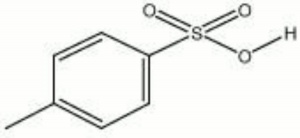Difference between revisions of "Para-toluenesulfonic acid"
Jump to navigation
Jump to search
(username removed) |
m (Text replace - "== Authority ==" to "== Sources Checked for Data in Record ==") |
||
| Line 40: | Line 40: | ||
[http://www.cdc.gov/niosh/ipcsneng/neng0773.html International Chemical Safety Card] | [http://www.cdc.gov/niosh/ipcsneng/neng0773.html International Chemical Safety Card] | ||
| − | == | + | == Sources Checked for Data in Record == |
* Richard S. Lewis, ''Hawley's Condensed Chemical Dictionary'', Van Nostrand Reinhold, New York, 10th ed., 1993 | * Richard S. Lewis, ''Hawley's Condensed Chemical Dictionary'', Van Nostrand Reinhold, New York, 10th ed., 1993 | ||
Revision as of 13:35, 1 May 2016
Description
Colorless, hygroscopic crystals used as an extender in soaps.
Synonyms and Related Terms
p-toluenesulfonate; p-toluenesulfonic acid, monohydrate; p-tolylsulfonic acid; p-TSA; tosic acid; 4-methylbenzenesulfonic acid; p-methylphenylsulfonic acid;
Other Properties
Soluble in ethanol, ether, water.
| Composition | C6H4(SO3H)(CH3) |
|---|---|
| CAS | 104-15-4 |
| Melting Point | 107 |
| Density | 1.24 |
| Molecular Weight | mol. wt. = 172.2 |
| Boiling Point | 140 |
Hazards and Safety
Combustible. Flash point = 184 C. Corrosive. Contact causes irritation and burns.
International Chemical Safety Card
Sources Checked for Data in Record
- Richard S. Lewis, Hawley's Condensed Chemical Dictionary, Van Nostrand Reinhold, New York, 10th ed., 1993
- Richard C. Wolbers, Nanette T. Sterman, Chris Stavroudis, Notes for Workshop on New Methods in the Cleaning of Paintings, J.Paul Getty Trust, Los Angeles, 1990
